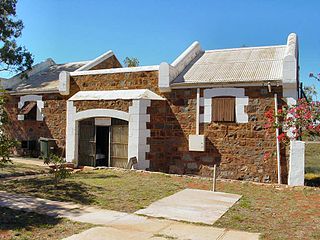The Pilbara is a large, dry, thinly populated region in the north of Western Australia. It is known for its Aboriginal peoples; its ancient landscapes; the red earth; and its vast mineral deposits, in particular iron ore. It is also a global biodiversity hotspot for subterranean fauna.

Kumpupintil Lake, formerly known as Lake Disappointment, is an endorheic salt lake located in the Little Sandy Desert, east of the Pilbara region of Western Australia.

Roebourne is a town in Western Australia's Pilbara region. In the Ngarluma language, Roebourne is called Yirramagardu (Ieramagadu). It is 35 km from Karratha, 202 km from Port Hedland and 1,563 km from Perth, the state's capital. It is the only town on the North West Coastal Highway between Binnu and Fitzroy Crossing; over 2,000km. It is located within the City of Karratha. It prospered during its gold boom of the late 19th century and was once the largest settlement between Darwin and Perth. At the 2016 census, Roebourne and the surrounding area had a population of 981.

Nullagine is an old goldrush town in Western Australia's Pilbara region. It is located on the Nullagine River 296 km south-east of Port Hedland and 1,364 km north-north-east of Perth on the old Great Northern Highway.
James Harding was a British-Australian pastoralist and explorer in colonial Western Australia. While exploring in the Kimberley region in 1864, he was killed by Aboriginal Australians. In February 1913, a monument to Panter, Harding, Goldwyer and Brown, the Explorers' Monument, was unveiled in Fremantle.

The Shire of East Pilbara is one of the four local government areas in the Pilbara region of Western Australia. With an area of 372,571 square kilometres (143,850 sq mi), larger than the Australian states of Victoria and Tasmania combined, it is the largest local government region in Australia. The Shire's seat of government, and home to nearly half the Shire's population, is the town of Newman in the shire's south-west.
The Pilbara strike was a landmark strike by Indigenous Australian pastoral workers in the Pilbara region of Western Australia. The strike lasted between 1946 and 1949, and was the longest industrial action in Australian history.
The Martukaja (Mardu) are a grouping of several Aboriginal Australian peoples in the Western Desert cultural bloc.
Jigalong is a remote Aboriginal community of approximately 333 people located in the Pilbara region of Western Australia.
Warralong is a small Aboriginal community, located 120 kilometres (75 mi) south east of Port Hedland and 50 kilometres (31 mi) north of Marble Bar in the Pilbara region of Western Australia, within the Shire of East Pilbara. The community lies between the Shaw and De Grey Rivers.

Punmu is an Aboriginal community, located 640 km south east of Port Hedland in the Pilbara region of Western Australia, within the Shire of East Pilbara.
Balfour Downs Station is a pastoral lease and cattle station located approximately 132 kilometres (82 mi) northeast of Newman, 88 kilometres (55 mi) east of Roy Hill and 108 kilometres (67 mi) southeast of Nullagine in the Pilbara region of Western Australia. At 6,395 square kilometres (2,469 sq mi), it is among the largest cattle stations in Australia.
Magabala Books is an Indigenous publishing house based in Broome, Western Australia.
James Isdell was an Australian pastoralist and politician who was a member of the Legislative Assembly of Western Australia from 1903 to 1906, representing the seat of Pilbara.
The Nyamal are an Indigenous Australian people of the Pilbara area of north-western Western Australia.
Daisy Bindi (1904—1962), also known as Mumaring, was an Aboriginal Australian Indigenous rights activist and a leader in the landmark 1946 Pilbara strike in Western Australia.
Michael Leslie is an Indigenous Australian dancer and choreographer.

Ysola Mary Best was an Australian author and elder of the Yugambeh people. Best is known for her works and role in preserving the language, history and culture of the Yugambeh. She wrote about aboriginal culture and history. Most of her published works are about the Yugambeh language group of South East Queensland.
The Native Administration Act, originally titled the 'Aborigines Act', and later renamed to the 'Native Welfare Act'; was a legislative act of the Western Australian legislature. Alongside the Aborigines Protection Act (1905), the act enabled the surveillance and control of Aboriginal people by agents of the colonial State government in the early 20th century.
Meentheena Station is a historic cattle station in Western Australia.






